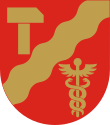| Tampereen Komediateatteri | |
 Theatre in 2017 | |
 | |
| Location | |
|---|---|
| Coordinates | 61°30′11″N23°45′55″E / 61.5031°N 23.7653°E |
| Construction | |
| Built | 1897 |
| Opened | 1991 |
| Architect | Georg Schreck |
| Website | |
| https://www.komediateatteri.fi | |
Tampere Comedy Theatre (Finnish Tampereen Komediateatteri) is theatre in Tampere that focuses on comedy. It was founded in 1991 by actor Esko Raipia and screenwriter and director Tapio Parkkinen. [1] The theatre's address is Lapintie 3, Tampere. [2]
Since 1994 the theatre is operated from Juhlatalo, a historic building in Tampere that was completed in 1897 and designed by Georg Schreck. In 2006 a new stage that can fit 256 viewers was completed. [1]
Apart from comedy, the theatre also hosts comedy and farces. [3] Since 1994 a theatre institution (Suomen teatteriopisto) has operated from the premise of the same building. The institution educates both amateur and professional actors. [4]
